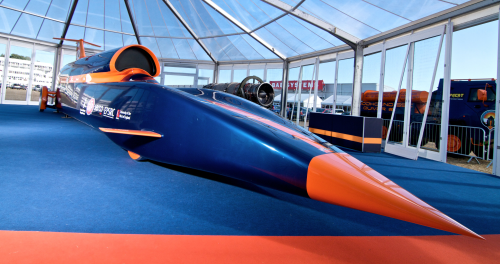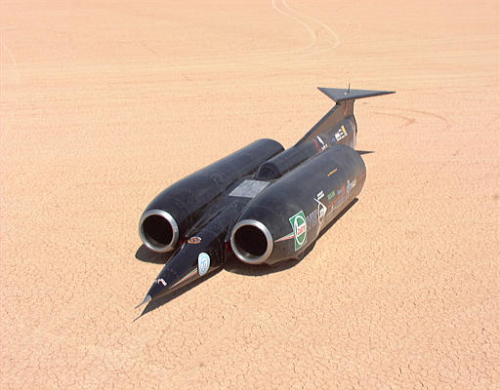

The BLOODHOUND SSC show car 12.8 m long, weighs 950 kg and separates into three sections. The 1:1 replica is the result of three years of aerodynamic study and 10 design evolutions designed to perfect the shape and aerodynamic package of the car.
Aerodynamic research using computational fluid dynamics was conducted by Swansea University, MathWorks and EPSRC (Engineering and Physical Sciences Research Council) in the UK. The BLOODHOUND aerodynamic team generated millions of mathematical equations to investigate how the air around the car would react as the car accelerates to its maximum design speed of 1050 mph. Using this information it then designed an efficient shape that would be stable at supersonic speeds.
The show car started out as 5 m3 polystyrene blocks, which were then cut into moulds using 3 axis machining by Baker Patterns of Birmingham, UK. Fibreglass and resin was then laid over the moulds in a process that took many thousands of hours to hand finish. The work was done by CHW Composites and Mike Horne Design on the Isle of Wight. The BLOODHOUND model was then given the six coats of Akzo Nobel aerospace paint by Aero-Composites, also based on the Isle of Wight.
The BLOODHOUND SSC supersonic car, currently under development, aims to outperform ThrustSSC, the first car to exceed the speed of sound (Mach 1, approximately 343 m/s) by travelling at 763.035 mph on the Black Rock Desert in Nevada, USA, on 15 October 1997. BLOODHOUND will be powered by a jet and hybrid rocket and substantial parts of the structure, including the driver’s safety cell, will be constructed from carbon fibre composites.
The car takes its name from the Bristol Bloodhound, a long range surface to sir missile developed in the UK during the 1950s.
The BLOODHOUND SSC team is based in the UK and headed by Richard Noble.





